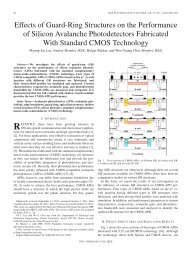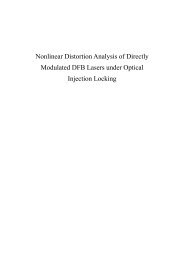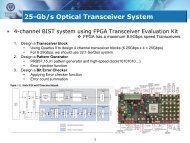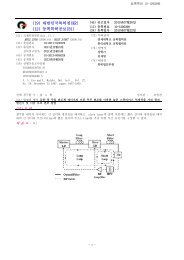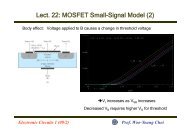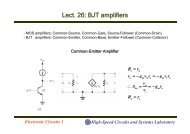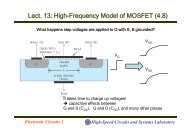SOA–EAM Frequency Up/Down-Converters for 60 ... - IEEE Xplore
SOA–EAM Frequency Up/Down-Converters for 60 ... - IEEE Xplore
SOA–EAM Frequency Up/Down-Converters for 60 ... - IEEE Xplore
Create successful ePaper yourself
Turn your PDF publications into a flip-book with our unique Google optimized e-Paper software.
964 <strong>IEEE</strong> TRANSACTIONS ON MICROWAVE THEORY AND TECHNIQUES, VOL. 54, NO. 2, FEBRUARY 2006Fig. 9. (a) RF spectrum of frequency up-converted downlink signals.(b) Constellation and eye diagram of the demodulated downlink QPSK datasignal.harmonics of the Mach–Zehnder modulator [21]. The smallpeaks around are due to cross-gain modulation betweenoptical LO and IF signals. The uplink optical spectrum wasmeasured after the optical bandpass filter (nm) atthe central station (measured at Point B in Fig. 7). As shown inFig. 8(b), the optical LO signals are suppressed approximately30 dB compared with optical IF signals. The side peaks aroundare the results of modulation of the EAM.The RF spectra and EVMs of frequency-converted QPSKdata signals were measured. Fig. 9(a) shows the RF spectrum offrequency up-converted downlink signals, and Fig. 9(b) showsthe constellation and eye diagram of demodulated downlinkdata. For this measurement, a 16.3-dBm optical LO and10-dBm optical IF signals were injected into the SOA, andthe resulting EVM was approximately 3.3%, which correspondsto 29.6-dB SNR. Fig. 10(a) shows the 150-MHz RF spectrumof frequency down-converted uplink signals measured at thecentral station, and Fig. 10(b) shows the constellation and eyediagram of demodulated uplink data. With 15-dBm opticalLO and 8-dBm optical IF signals injected into the SOA, theEVM of 7.4% was obtained, which corresponds to 22.6-dBSNR.Fig. 10. (a) RF spectrum of the frequency down-converted uplink signals.(b) Constellation and eye diagram of the demodulated uplink QPSK data signal.Fig. 11. Measured EVMs as a function of SOA input optical IF signal power<strong>for</strong> downlink and uplink.We also measured EVMs as a function of optical IF powerbe<strong>for</strong>e the SOA <strong>for</strong> both downlink and uplink. Fig. 11 showsthe measurement results. The optical LO power was fixed at16.3 dBm <strong>for</strong> downlink and 15 dBm <strong>for</strong> uplink. As shownin this figure, downlink EVM changes from 6% to 3% as opticalIF power increases. This is simply because lower optical
SEO et al.: <strong>SOA–EAM</strong> FREQUENCY UP/DOWN-CONVERTERS FOR <strong>60</strong>-GHz BI-DIRECTIONAL RoF SYSTEMS 965were frequency down-converted from <strong>60</strong>-GHz band and, afteroptical IF modulation, transmitted to the central station. Themeasured EVMs confirmed high-quality data transmission <strong>for</strong>both links <strong>for</strong> a wide range of optical IF wavelengths. We believethat this frequency converter is very useful <strong>for</strong> simplifyingbase stations and achieving flexible bi-directional RoF systems.REFERENCESFig. 12. Measured EVMs as a function of optical IF signal wavelength <strong>for</strong>downlink and uplink.IF power reduces cross-gain modulation efficiency and the frequencyup-converted signal power. However, when optical IFpower is high, both cross-gain modulation efficiency and SOAgain of optical LO signals are saturated and, consequently, theEVM is also saturated at around 3%.The EVM of the uplink data transmission also decreases from13% to 8% as optical IF power increases. In uplink, the increasein optical IF power leads to increase in the detected uplink signalpower, causing an increase in the SNR. Consequently, the EVMdecreases until it is saturated due to SOA gain saturation. Althoughlarge EVMs were measured at low optical IF power conditions,their values are still good enough <strong>for</strong> QPSK data transmission.The dependence of EVM on an optical IF wavelength wasalso investigated in order to identify the usable IF wavelengthrange. The optical LO power was 16.3 dBm <strong>for</strong> downlink and15 dBm <strong>for</strong> uplink, and optical IF power was 10 dBm <strong>for</strong>downlink and 8 dBm <strong>for</strong> uplink. As shown in Fig. 12, EVMs<strong>for</strong> both downlink and uplink do not change very much with opticalIF wavelength. This verifies that optical IF signals havingdifferent wavelengths can be used <strong>for</strong> accessing different basestations, as shown in Fig. 1.V. CONCLUSIONWe experimentally investigated and demonstrated thecascaded <strong>SOA–EAM</strong> millimeter-wave frequency up/downconverter <strong>for</strong> bi-directional RoF systems. This configurationuses SOA cross-gain modulation and EAM photodetection<strong>for</strong> frequency up-conversion, and EAM nonlinearity <strong>for</strong> frequencydown-conversion. With this single configuration andremotely fed optical LO and IF signals, both frequency up- anddown-conversion are possible, which makes the base stationvery simple and RoF systems very flexible. We found that EAMbiases affect frequency up- and down-conversion efficiencies. Itwas also found that high optical LO power provides high conversionefficiencies. We experimentally demonstrated <strong>60</strong>-GHzbi-directional RoF systems using the <strong>SOA–EAM</strong> frequencyconverter. 10-Mb/s QPSK data at 100-MHz IF were opticallytransmitted to the base station and frequency up-converted to<strong>60</strong>-GHz band. For uplink, 10-Mb/s QPSK data at 150-MHz IF[1] J. Mikkonen, C. Corrado, C. Evci, and M. Prögler, “Emerging wirelessbroad-band networks,” <strong>IEEE</strong> Commun. Mag., pp. 112–117, Feb. 1998.[2] P. Smulders, “Exploiting the <strong>60</strong> GHz band <strong>for</strong> local wireless multimediaaccess: Prospects and future directions,” <strong>IEEE</strong> Commun. Mag., pp.140–147, Jan. 2002.[3] H. Ogawa, D. Polifko, and S. Banda, “Millimeter-wave fiber optics systems<strong>for</strong> personal radio communication,” <strong>IEEE</strong> Trans. Microw TheoryTech., vol. 40, no. 12, pp. 2285–2293, Dec. 1992.[4] L. Noël, D. Wake, D. G. Moodie, D. D. Marcenac, L. D. Westbrook,and D. Nesset, “Novel technique <strong>for</strong> high-capacity <strong>60</strong> GHz fiber-radiotransmission systems,” <strong>IEEE</strong> Trans. Microw Theory Tech., vol. 45, no.8, pp. 1416–1423, Aug. 1997.[5] A. J. Seeds, “Microwave photonics,” <strong>IEEE</strong> Trans. Microw Theory Tech.,vol. 50, no. 3, pp. 877–887, Mar. 2002.[6] U. Gliese, S. Nørskov, and T. N. Nielsen, “Chromatic dispersion infiber-optic microwave and millimeter-wave links,” <strong>IEEE</strong> Trans. MicrowTheory Tech., vol. 44, no. 10, pp. 1716–1724, Oct. 1996.[7] H. Sotobayashi and K. Kitayama, “Cancellation of the signal fading<strong>for</strong> <strong>60</strong> GHz subcarrier multiplexed optical DSB signal transmission innondispersion shifted fiber using midway optical phase conjugation,” J.Lightw. Technol., vol. 17, no. 12, pp. 2488–2497, Dec. 1999.[8] F. Ramos, J. Marti, and V. Polo, “Compensation of chromatic dispersioneffects in microwave/millimeter-wave optical systems usingfour-wave-mixing induced in dispersion-shifted fibers,” <strong>IEEE</strong> Photon.Technol. Lett., vol. 11, no. 9, pp. 1171–1173, Sep. 1999.[9] E. Suematsu and N. Imai, “A fiber-optic/millimeter-wave radio transmissionlink using HBT as direct photodetector and an optoelectronicupconverter,” <strong>IEEE</strong> Trans. Microw Theory Tech., vol. 44, no. 1, pp.133–143, Jan. 1996.[10] G. H. Smith, D. Novak, and Z. Ahmed, “Overcoming chromatic-dispersioneffects in fiber-wireless systems incorporating external modulators,”<strong>IEEE</strong> Trans. Microw Theory Tech., vol. 45, no. 8, pp. 1410–1415,Aug. 1997.[11] M. Tsuchiya and T. Hoshida, “Nonlinear photodetection scheme and itssystem applications to fiber-optic millimeter-wave wireless down-links,”<strong>IEEE</strong> Trans. Microw Theory Tech., vol. 47, no. 7, pp. 1342–1350, Jul.1999.[12] M. Ogusu, K. Inagaki, Y. Mizuguchi, and T. Ohira, “Carrier generationand data transmission on millimeter-wave bands using two-mode lockedFabry–Perot slave lasers,” <strong>IEEE</strong> Trans. Microw Theory Tech., vol. 51, no.2, pp. 382–391, Feb. 2003.[13] T. Kuri, K. Kitayama, and Y. Ogawa, “Fiber-optic millimeter-wave uplinksystem incorporating remotely fed <strong>60</strong>-GHz-band optical pilot tone,”<strong>IEEE</strong> Trans. Microw Theory Tech., vol. 47, no. 7, pp. 1332–1337, Jul.1999.[14] Y.-K. Seo, J.-H. Seo, and W.-Y. Choi, “Photonic frequency upconversionefficiencies in semiconductor optical amplifiers,” <strong>IEEE</strong> Photon. Technol.Lett., vol. 15, no. 5, pp. 751–753, May 2003.[15] J.-H. Seo, Y.-K. Seo, and W.-Y. Choi, “Spurious-free dynamic rangecharacteristics of the photonic up-converter based on a semiconductoroptical amplifier,” <strong>IEEE</strong> Photon. Technol. Lett., vol. 15, no. 11, pp.1591–1593, Nov. 2003.[16] J. Lim, Y.-S. Kang, K.-S. Choi, J.-H. Lee, S.-B. Kim, and J. Kim, “Analysisand characterization of traveling-wave electrode in electroabsorptionmodulator <strong>for</strong> radio-on-fiber application,” J. Lightw. Technol., vol.21, no. 12, pp. 3004–3010, Dec. 2003.[17] K. Kitayama, A. Stöhr, T. Kuri, R. Heinzelmann, D. Jäger, and Y. Takahashi,“An approach to single optical component antenna base stations<strong>for</strong> broad-band millimeter-wave fiber-radio access systems,” Trans. MicrowTheory Tech., vol. 48, no. 12, pp. 2588–2595, Dec. 2000.[18] J.-H. Seo, C.-S. Choi, W.-Y. Choi, Y.-S. Kang, Y.-D. Chung, and J. Kim,“Remote optoelectronic frequency down-conversion using <strong>60</strong> GHz opticalheterodyne signals and electroabsorption modulator,” <strong>IEEE</strong> Photon.Technol. Lett., vol. 17, no. 5, pp. 1073–1075, May 2005.
966 <strong>IEEE</strong> TRANSACTIONS ON MICROWAVE THEORY AND TECHNIQUES, VOL. 54, NO. 2, FEBRUARY 2006[19] K. Asaka, Y. Suzaki, Y. Kawaguchi, S. Kondo, Y. Noguchi, H. Okamoto,R. Iga, and S. Oku, “Lossless electroabsorption modulator monolithicallyintegrated with a semiconductor optical amplifier and a passivewaveguide,” <strong>IEEE</strong> Photon. Technol. Lett., vol. 15, no. 5, pp. 679–681,May 2003.[20] D. M. Pozar, Microwave and RF Design of Wireless Systems. NewYork: Wiley, 2001.[21] J. O’Reilly and P. Lane, “Remote delivery of video services usingmm-waves and optics,” J. Lightw. Technol., vol. 12, no. 2, pp. 369–375,Feb. 1994.Jun-Hyuk Seo was born in Seoul, Korea, 1977.He received the B.S. and M.S. degrees in electricaland electronic engineering from Yonsei University,Seoul, Korea, in 2000 and 2002, respectively,and currently working toward the Ph.D. degree atYonsei University. His doctoral dissertation concernsmillimeter-wave RoF systems based on SOAs andEAMs.His other interests include optical generation ofmillimeter-wave signals, laser nonlinearities, andoptical/opto-electronic frequency converters.Chang-Soon Choi was born in Seoul, Korea, on1977. He received the B.S., M.S., and Ph.D. degreesin electrical and electronic engineering from YonseiUniversity, Seoul, Korea, in 1999, 2001, and 2005,respectively. His doctoral dissertation concernedInP-based phototransistors and their applications tomicrowave/millimeter-wave photonics systems.In 2005, he joined the National Institute of In<strong>for</strong>mationand Communication Technology (NICT),Yokosuka, Japan, where he is engaging in researchon millimeter-wave broad-band wireless communicationnetworks and millimeter-wave photonics systems. His other researchinterests include opto-electronic monolithic millimeter-wave integrated circuitsand optical generation of millimeter waves.Young-Shik Kang received the B.S. degree inphysics from Chungnam National University,Daejeon, Korea, in 1998, and the M.S. degree inin<strong>for</strong>mation and communications from the GwangjuInstitute of Science and Technology (GIST),Gwangju, Korea, in 2000.In 2001, he joined the integrated optical sourceteam as a Research Engineer involved with a projectconcerning a <strong>60</strong>-GHz analog optical modulator andtransceiver module <strong>for</strong> RF/optic conversion withthe Electronics and Telecommunications ResearchInstitute (ETRI), Deajeon, Korea. His current research concerns monolithicallyintegrated analog optical transceiver chips.Yong-Duck Chung received the B.S., M.S., andPh.D. degrees in physics from Yonsei University,Seoul, Korea, in 1995, 1997, and 2002, respectively.In 2002, he joined the Electronics and TelecommunicationsResearch Institute (ETRI), Daejeon, Korea,where he is currently a Senior Researcher. His researchhas concerned an integrated WDM transmitter<strong>for</strong> metro and access networks. He is currently involvedin a project on a <strong>60</strong>-GHz analog optical modulatorand transceiver module <strong>for</strong> RF/optic conversion.His research interests are the fabrication and characterizationof high-speed photonic and opto-electronic devices. He also has interestsin RoF link wireless systems.Jeha Kim received the B.S. and M.S. degrees fromSogang University, Seoul, Korea, in 1982 and 1985,respectively, and the Ph.D. degree from the Universityof Arizona, Tucson, in 1993, all in physics.In 1993, he joined the Electronics and TelecommunicationsResearch Institute (ETRI), Daejeon,Korea, where he was involved with the OptoelectronicsSection in the development of a 10-Gbit/slaser diode <strong>for</strong> optical communications. From 1995to 1998, he was involved with high-temperature superconducting(HTS) passive and active microwavedevices <strong>for</strong> high-sensitivity wireless communications. He is currently the TeamLeader of the integrated optical source team and a Principal Investigator inthe projects of hybrid integrated wavelength-selectable WDM optical sourcemodules and <strong>60</strong>-GHz analog optical modulator and transceiver modules <strong>for</strong>RF/optic conversion. His current research interests concern the development offunctional opto-electronic devices <strong>for</strong> WDM and optical time-domain multiplexing(OTDM) fiber-optic communications and RoF link wireless systems.Woo-Young Choi received the B.S., M.S., and Ph.D.degrees in electrical engineering and computer sciencefrom the Massachusetts Institute of Technology(MIT), Cambridge, in 1986, 1988, and 1994, respectively.His doctoral dissertation concerned the investigationof molecular beam epitaxy (MBE)-grown In-GaAlAs laser diodes <strong>for</strong> fiber-optic applications.From 1994 to 1995, he was a Post-Doctoral ResearchFellow with NTT Opto-Electronics Laboratories,where he was involved with femto-second allopticalswitching devices based on low-temperaturegrownInGaAlAs quantum wells. In 1995, he joined the Department of Electricaland Electronic Engineering, Yonsei University, Seoul, Korea, where he iscurrently a Professor. His research interest is in the area of high-speed circuitsand systems that include high-speed electronic circuits, high-speed opto-electronics,and microwave photonics.



